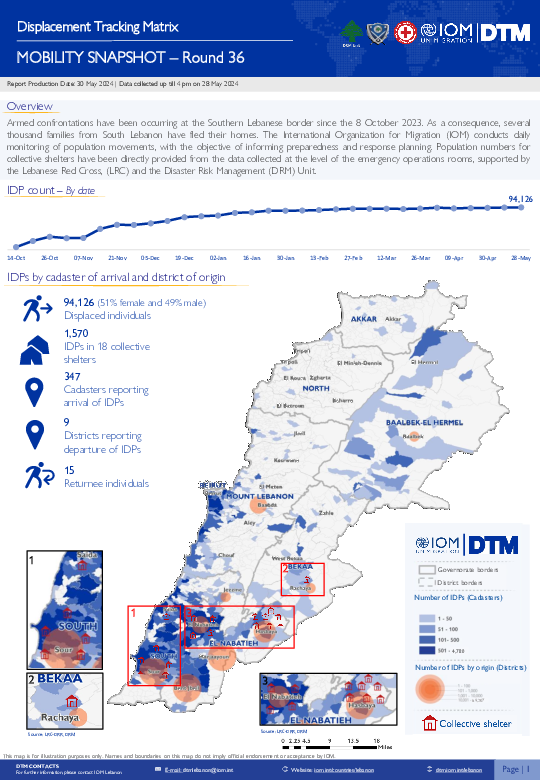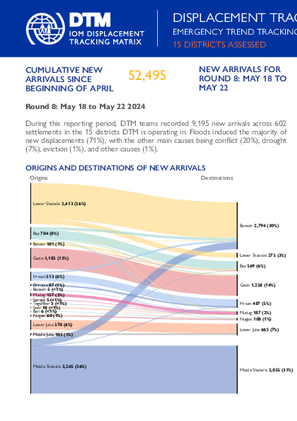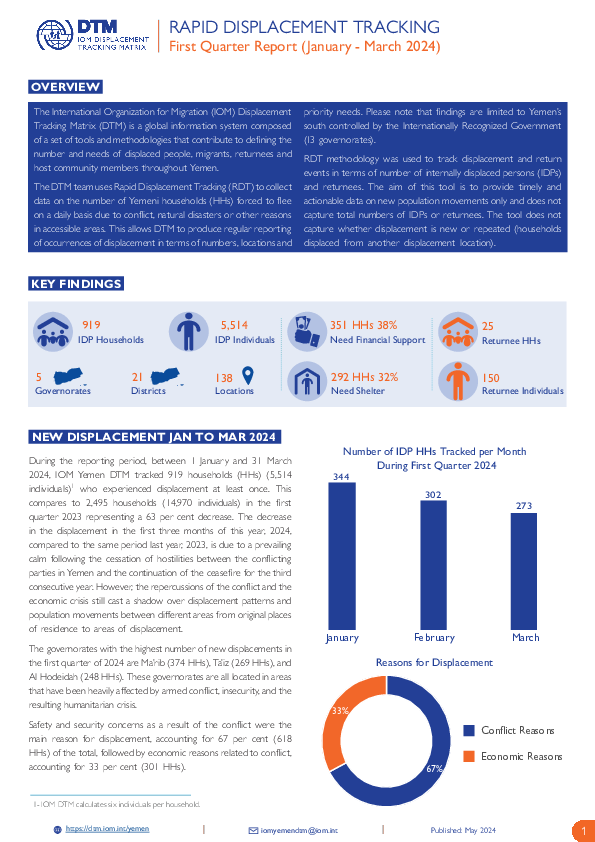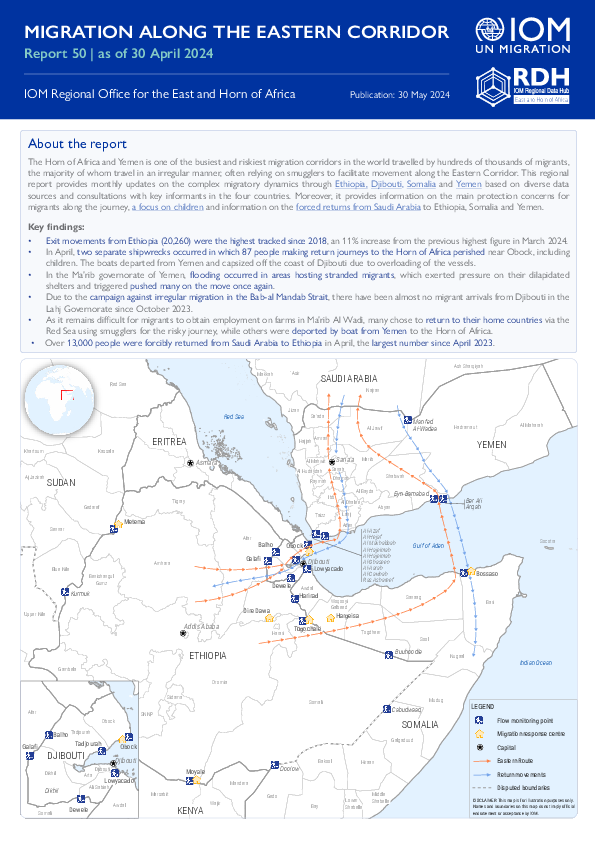-
Countries
-
Data and Analysis
-
Special Focus
-
Crisis Responses

Contact
DTMUkraine@iom.int
Language
English
Location
Ukraine
Period Covered
Mar 10 2024
Apr 11 2024
Activity
- Survey
Between 10 March and 11 April 2024, the International Organization for Migration (IOM) conducted Round 16 of the General Population Survey (GPS), a highly representative assessment of internal displacement in Ukraine. The data presented in this report was commissioned by the International Organization for Migration (IOM) and collected by 59 enumerators employed by Multicultural Insights through screener phone-based interviews with 20,000 randomly selected respondents and follow-up interviews with 1,428 IDPs, 1,639 returnees, and 2,266 residents, using the computer-assisted telephone interview (CATI) method, and a random digit dial (RDD) approach.
This report provides the main findings from Round 16 of the GPS, including detailed insights into population figures, displacement flows and mobility intentions, demographic profiles, household composition and vulnerabilities, and needs of the displaced population, to facilitate evidence-based decision-making on strategic, technical, and programmatic aspects of the response and recovery efforts in Ukraine.

Contact
DTM Zimbabwe, DTMzimbabwe@iom.int, DTMsupport@iom.int
Language
English
Location
Zimbabwe
Period Covered
Apr 01 2024
Apr 30 2024
Activity
- Flow Monitoring
During the reporting period, a total of 55,495 movements were recorded and 2,122 migrants were interviewed across 20 Flow Monitoring Points (FMPs) in Zimbabwe. The total movements recorded decreased by 5% compared to the previous month. Sixty-five per cent of movements observed were inflows, whilst 35% were outflows. The top three sending districts were Beitbridge (59%), Harare (9%) and Chiredzi (9%), whilst the top three receiving districts were Harare (39%), Bulawayo (14%) and Beitbridge (13%). Matabeleland South province recorded the highest number of outflows (59%) whilst Harare province recorded the highest number of inflows (40%).
The South Africa-Zimbabwe corridor recorded the highest movement of 50,680 (91%) followed by the Zambia-Zimbabwe corridor which recorded 4,815 (9%) movements. Fifty-four per cent of movements along the South Africa-Zimbabwe corridor were short-term movements, 22% were long-term economic movements whilst 21% were family reunification movements. Of the migrants travelling from South Africa, 34% travelled to Harare, 16% to Beitbridge and 14% were headed to Bulawayo.
The Zambia-Zimbabwe corridor consisted of 54% short-term movements, 24% long-term economic movements and 21% family reunification movements. Of the migrants travelling from Zambia, 68% were travelling to Harare, 16% to Hurungwe and 8% to Bulawayo.
Migrants travelling from Matabeleland South highlighted Limpopo (76%) and Gauteng, South Africa (21%) as their intended destination. Of the incoming migrants travelling to Harare, 54% were travelling from Gauteng (South Africa) whilst 24% were travelling from Lusaka province in Zambia.

Contact
dtmlebanon@iom.int
Language
English
Location
Lebanon
Period Covered
Oct 10 2023
May 28 2024
Activity
- Mobility Tracking
- Baseline Assessment
Since October 8 there has been an increase in cross-border incidents between Israel and Lebanon, resulting in the displacement of people both within the South and elsewhere within the country. Since October 10, the Displacement Tracking Matrix (DTM) has been conducting the daily monitoring of population movements. The objective of the exercise is to inform preparedness and response planning.

Contact
DTM Sudan, SudanDTM@iom.int
Language
English
Location
Sudan
Period Covered
May 08 2024
May 21 2024
Activity
- Other
Following the increase in localized displacement due to fires, DTM Sudan released the following report summarizing DTM updates on displacement due to fire incidents across Sudan, from 08 May to 21 May 2024.
DTM field teams reported five fire incidents across North Darfur (1), North Kordofan (2), White Nile (1), and Northern (1) states. Some fires were reportedly caused by increased temperatures and drier climate conditions, while others were due to household accidents.
Highlights
- Fires displaced an estimated 575 individuals (approximately 115 households) between 08 May and 21 May 2024.
- Over 133 structures (126 houses and seven farms) were destroyed or partially damaged by the fires.
- The fires resulted in localized displacement: the majority of displaced households sought shelter with host communities within the same locations.
• Exit movements from Ethiopia (20,260) were the highest tracked since 2018, an 11% increase from the previous highest figure in March 2024.
• In April, two separate shipwrecks occurred in which 87 people making return journeys to the Horn of Africa perished near Obock, including children. The boats departed from Yemen and capsized off the coast of Djibouti due to overloading of the vessels.
• In the Ma’rib governorate of Yemen, flooding occurred in areas hosting stranded migrants, which exerted pressure on their dilapidated
shelters and triggered pushed many on the move once again.
• Due to the campaign against irregular migration in the Bab-al Mandab Strait, there have been almost no migrant arrivals from Djibouti in the
Lahj Governorate since October 2023.
• As it remains difficult for migrants to obtain employment on farms in Ma’rib Al Wadi, many chose to return to their home countries via the
Red Sea using smugglers for the risky journey, while others were deported by boat from Yemen to the Horn of Africa.
• Over 13,000 people were forcibly returned from Saudi Arabia to Ethiopia in April, the largest number since April 2023.

Contact
DTM Somalia, IOMSomaliaDTM@iom.int
Language
English
Location
Somalia
Period Covered
May 18 2024
May 22 2024
Activity
- Mobility Tracking
- Baseline Assessment
This latest round of Emergency Trends Tracking was initiated in April 2024 to monitor displacements movements during the Gu rainy season. Districts covered in this round include Afgooye, Afmadow, Baardheere, Baidoa, Balcad, Belet Weyne, Gaalkacyo, Garoowe, Jamaame, Jowhar, Kismaayo, and Luuq.
ETT is a crisis-based tool that tracks sudden displacement triggered by specific events or emerging crises. The objective of ETT is to help prioritize humanitarian response and to enable partners to deliver rapid assistance. Based on previous shock induced displacement patterns, the humanitarian community expects that people will continue to move toward urban areas in search of humanitarian services. Consequently, the ETT coverage focuses on the main urban centers and surrounding villages for each assessed district. The data is collected through Key Informant Interviews (KIIs) at the location level, from Sunday to Wednesday every week. It includes information on new arrivals, numbers and demographic of IDPs, reasons for displacement, intentions, humanitarian assistance and priority needs among others.

Contact
DTM Europe, DTMMediterranean@iom.int
Language
English
Location
Bosnia & Herzegovina
Period Covered
Apr 01 2024
Apr 30 2024
Activity
- Flow Monitoring
This report provides insights into the profiles, experiences, needs, routes travelled and intentions of migrants transiting through Bosnia and Herzegovina (BiH). Data was collected from 1 to 30 April 2024. IOM carried out a route observation exercise in the Republika Srpska, Sarajevo Canton, Posavina Canton, Tuzla Canton, Bosnian-Podrinje Canton and Una Sana Canton to monitor trends in entries and exits as well as transit modalities within BiH. IOM also surveyed 553 migrants in active transit locations such as bus stops or at key entry and exit locations throughout the country as well as in four transit reception centres (TRCs) in BiH (Lipa, Ušivak, Borići and Blažuj).

Contact
DTM Sudan; dtmsudan@iom.int
Language
English
Location
Sudan
Period Covered
Apr 26 2024
May 08 2024
Activity
- Mobility Tracking
- Baseline Assessment
This report reflects data corresponding to Sudan Mobility Update (1) dataset. The dataset is available here.
Overview:
This report provides an overview of the total population of internally displaced persons (IDPs) in Sudan, including those displaced both before and after the onset of conflict on 15 April 2023.
The displacement crisis in Sudan has been unfolding for over two decades, with roots in the Darfur conflict beginning in 2003. Prior to the onset of conflict on 15 April 2023, Sudan already hosted an estimated 3,820,772 IDPs. The majority (80%) reportedly originated from Darfur states, and most were initially displaced between 2003 and 2010. Of these IDPs, many experienced secondary displacement after 15 April 2023. Since 15 April 2023, an estimated 7,111,788 individuals were displaced internally within Sudan — including those who experienced secondary displacement.
When accounting for those displaced both before and after 15 April 2023, DTM estimated that Sudan hosted a total of 9,957,655 IDPs.
Key Findings:
- An estimated total of 9,957,655 IDPs were displaced across 7,869 locations, in 183 localities in all 18 states in Sudan.
- An estimated 7,111,788 individuals were displaced internally within Sudan since 15 April 2023.
- An estimated 26 per cent of IDPs who were initially displaced prior to the onset of current conflict experienced secondary displacement since 15 April 2023.
- Approximately 2,111,791 individuals crossed borders into neighbouring countries since 15 April 2023.
- The top states of origin among IDPs were Khartoum (36%), South Darfur (21%), and North Darfur (12%).
- The states hosting the most IDPs were South Darfur (18%), North Darfur (13%) and Central Darfur (9%).
- Over half (56%) of IDPs were reportedly children under the age of 18-years-old.
Note: The number of IDPs displaced post 15 April 2023 (7,111,788 IDPs) includes the estimated 974,905 IDPs who were initially displaced prior to 15 April 2023 and experienced secondary displacement since 15 April 2023. DTM Sudan defines an internally displaced person as any person who has been forced or obliged to flee from their habitual residence due to an event dating from 2003 onwards.
Contact
DTM Yemen, iomyemendtm@iom.int
Location
Yemen
Activity
- Mobility Tracking
- Event Tracking
Period Covered
Jan 01 2024 -Mar 31 2024
From 1 January to 31 March 2024, IOM Yemen DTM tracked 919 households (HH) (5,514 Individuals) who experienced displacement at least once.
Between 1 January and 31 March 2024, IOM Yemen DTM tracked 919 households (5514 individuals) displaced at least once. The majority of people moved into/within the following governorates and districts:
- Ma’rib (374 HHs) – Marib City (199 HHs), Marib (129 HHs), Harib (46 HHs) districts. Most displacements in the governorate originated from Marib and Al Hodeidah.
- Ta’iz (269 HHs) – Jabal Habashi (168 HHs), Al Makha (33 HHs), Al Maafer (24 HHs) districts. Most displacements in the governorate were internal.
- Al Hodeidah (248 HHs) – Al Khukhah (135 HHs), Hays (113 HHs) districts. Most displacements in the governorate originated from Al Hodeidah and Taiz.
The majority of people moved from the following governorates and districts:
- Ta’iz (360 HHs) – Jabal Habashi (16 HHs), Mawza (3 HHs), Hayfan (1 HH) districts.
- Al Hodeidah (248 HHs) – Bajil (6 HHs), As Sukhnah (5 HHs), Jabal Ras (1 HH) districts.
- Ma’rib (97 HHs) – Majzar (2 HHs), Al Jubah (1 HH) districts.
Population Groups
IDPs
Returnee (Previously Internally Displaced)
Survey Methodology
Unit of Analysis Or Observation
Admin Area 2
Household
Site or Location
Type of Survey or Assessment
Household
Key Informant
Keywords
Geographical Scope Partial Coverage
Administrative boundaries with available data
The current dataset covers the following administrative boundaries

Contact
DTM Yemen, iomyemendtm@iom.int
Language
English
Location
Yemen
Period Covered
Jan 01 2024
Mar 31 2024
Activity
- Mobility Tracking
- Event Tracking
During the reporting period, between 1 January and 31 March 2024, IOM Yemen DTM tracked 919 households (HHs) (5,514 individuals)1 who experienced displacement at least once. This compares to 2,495 households (14,970 individuals) in the first quarter 2023 representing a 63 per cent decrease. The decrease in the displacement in the first three months of this year, 2024, compared to the same period last year, 2023, is due to a prevailing calm following the cessation of hostilities between the conflicting parties in Yemen and the continuation of the ceasefire for the third consecutive year. However, the repercussions of the conflict and the economic crisis still cast a shadow over displacement patterns and population movements between different areas from original places of residence to areas of displacement.
The governorates with the highest number of new displacements in the first quarter of 2024 are Ma’rib (374 HHs), Ta’iz (269 HHs), and Al Hodeidah (248 HHs). These governorates are all located in areas that have been heavily affected by armed conflict, insecurity, and the resulting humanitarian crisis.
Safety and security concerns as a result of the conflict were the main reason for displacement, accounting for 67 per cent (618 HHs) of the total, followed by economic reasons related to conflict, accounting for 33 per cent (301 HHs).

